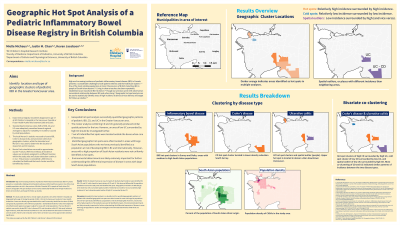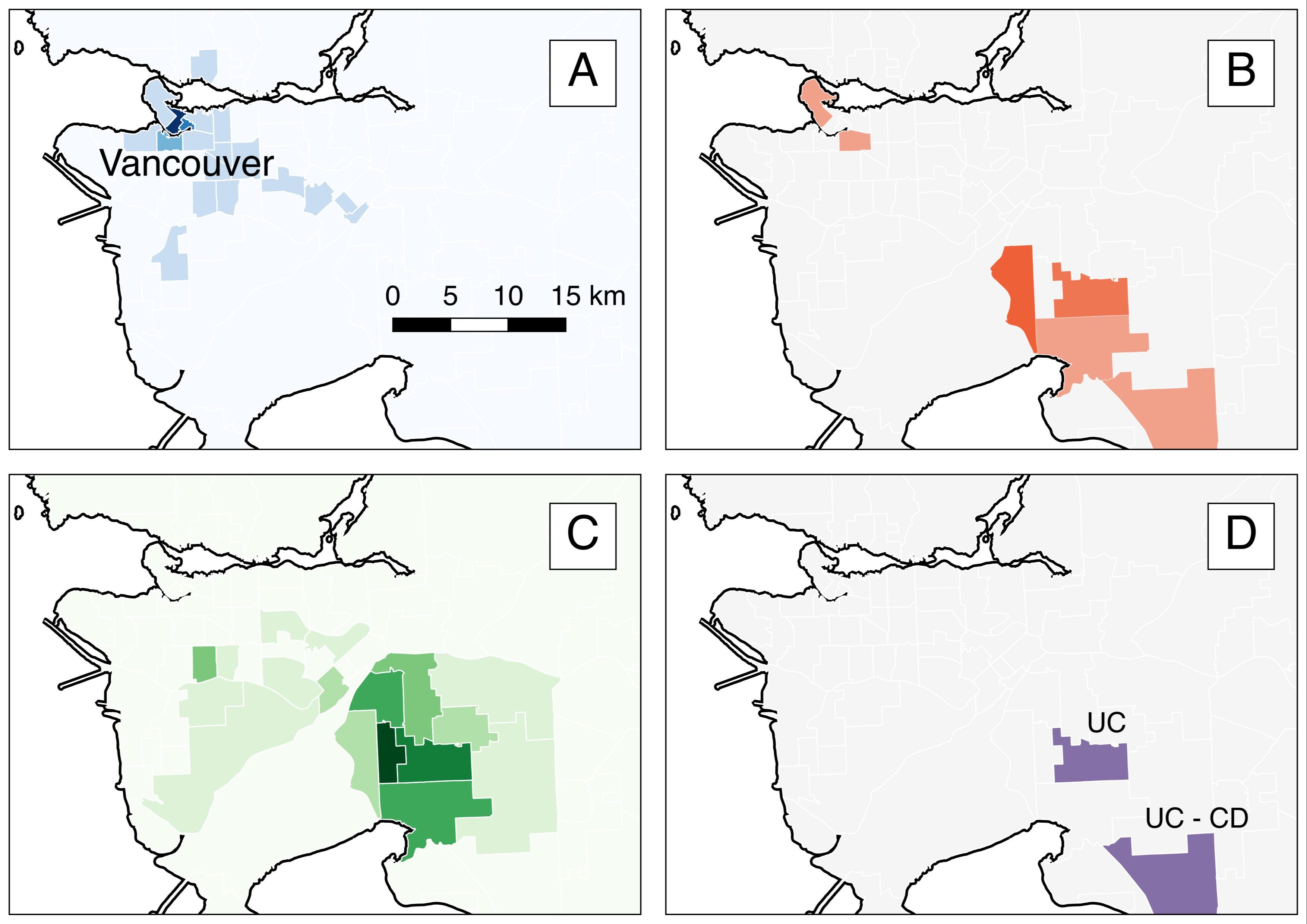Tuesday Poster Session
Category: IBD
P3595 - Geographic Hot Spot Analysis of a Pediatric Inflammatory Bowel Disease Registry in British Columbia
Tuesday, October 24, 2023
10:30 AM - 4:00 PM PT
Location: Exhibit Hall

Has Audio

Mielle Michaux, BA, MSc
UBC and British Columbia Children’s Hospital Research Institute
Vancouver, BC, Canada
Presenting Author(s)
Mielle Michaux, BA, MSc1, Justin M. Chan, BSc, MSc2, Kevan Jacobson, MBBCh1
1UBC and British Columbia Children’s Hospital Research Institute, Vancouver, BC, Canada; 2British Columbia Children’s Hospital Research Institute and UBC Faculty of Medicine, Vancouver, BC, Canada
Introduction: High and increasing incidence of pediatric inflammatory bowel disease (IBD) in Canada presents a considerable challenge to both patient wellness and the healthcare system. One of the most notable populations at risk in the province of British Columbia (BC) is people of South Asian (SA) descent. Geographic hot spot analysis can be used to statistically identify areas of high incidence to direct service delivery and target for followup studies.
Methods: This study used data from a clinical registry of patients seen at BC Children’s Hospital and diagnosed before age 17 during the period of 2003 - 2016 in the Vancouver Coastal or Fraser Health Authorities. Cases were directly age-standardized for small Community Health Services Areas (CHSAs) using 2011 BC population as the reference population.
Standardized incidence ratios were adaptively smoothed toward regional averages to adjust for areas with small populations. The local Moran’s I statistic was used to locate IBD, Crohn’s disease (CD), and ulcerative colitis (UC) hot spots (relatively high incidence), while the bivariate local Moran’s I was used to determine the location of shared UC and CD clusters. Monte Carlo simulation with a Holm correction was used to approximate statistical significance .
This study was approved by the UBC Children's and Women's Research Ethics Board.
Results: Within the Greater Vancouver area [A], hot spots of relatively high incidence [B] were identified for IBD, CD, and UC, with shared hot spot clusters of CD and UC. We observed differential SA population distribution [C] across the study area and identified hot spots. Geographical variations in IBD subtype were observed, with a univariate spatial outlier of relatively low incidence UC surrounded by high incidence UC [D] and a bivariate spatial outlier of high UC surrounded by low CD [D].
Discussion: Geospatial hot spot analysis is a valuable tool for quantifying geographic patterns of pediatric IBD. Identified geographic hot spots were often located in areas with large SA populations who we have previously identified as a population at risk of developing IBD. However, not all areas with a high proportion of SA residents were part of identified hot spots. Environmental determinants are likely extremely important for further understanding this differential expression of disease in areas with large SA populations. Studies to investigate environmental determinants of IBD in BC are underway.

Disclosures:
Mielle Michaux, BA, MSc1, Justin M. Chan, BSc, MSc2, Kevan Jacobson, MBBCh1. P3595 - Geographic Hot Spot Analysis of a Pediatric Inflammatory Bowel Disease Registry in British Columbia, ACG 2023 Annual Scientific Meeting Abstracts. Vancouver, BC, Canada: American College of Gastroenterology.
1UBC and British Columbia Children’s Hospital Research Institute, Vancouver, BC, Canada; 2British Columbia Children’s Hospital Research Institute and UBC Faculty of Medicine, Vancouver, BC, Canada
Introduction: High and increasing incidence of pediatric inflammatory bowel disease (IBD) in Canada presents a considerable challenge to both patient wellness and the healthcare system. One of the most notable populations at risk in the province of British Columbia (BC) is people of South Asian (SA) descent. Geographic hot spot analysis can be used to statistically identify areas of high incidence to direct service delivery and target for followup studies.
Methods: This study used data from a clinical registry of patients seen at BC Children’s Hospital and diagnosed before age 17 during the period of 2003 - 2016 in the Vancouver Coastal or Fraser Health Authorities. Cases were directly age-standardized for small Community Health Services Areas (CHSAs) using 2011 BC population as the reference population.
Standardized incidence ratios were adaptively smoothed toward regional averages to adjust for areas with small populations. The local Moran’s I statistic was used to locate IBD, Crohn’s disease (CD), and ulcerative colitis (UC) hot spots (relatively high incidence), while the bivariate local Moran’s I was used to determine the location of shared UC and CD clusters. Monte Carlo simulation with a Holm correction was used to approximate statistical significance .
This study was approved by the UBC Children's and Women's Research Ethics Board.
Results: Within the Greater Vancouver area [A], hot spots of relatively high incidence [B] were identified for IBD, CD, and UC, with shared hot spot clusters of CD and UC. We observed differential SA population distribution [C] across the study area and identified hot spots. Geographical variations in IBD subtype were observed, with a univariate spatial outlier of relatively low incidence UC surrounded by high incidence UC [D] and a bivariate spatial outlier of high UC surrounded by low CD [D].
Discussion: Geospatial hot spot analysis is a valuable tool for quantifying geographic patterns of pediatric IBD. Identified geographic hot spots were often located in areas with large SA populations who we have previously identified as a population at risk of developing IBD. However, not all areas with a high proportion of SA residents were part of identified hot spots. Environmental determinants are likely extremely important for further understanding this differential expression of disease in areas with large SA populations. Studies to investigate environmental determinants of IBD in BC are underway.

Figure: A) Greater Vancouver population density reference map. Darker color indicates higher population density. B) Identified hot spots of relatively high incidence for IBD, CD, and UC. Darker color indicates hot spots identified in multiple analyses. C) South Asian ethnic origin of the population. Percentages are categorized into intervals spanning 10%, with the palest green color representing 0 - 10% South Asian population and the darkest green color representing 60 - 70%. D) Identified spatial outliers (low UC surrounded by high UC and high UC surrounded by low CD).
Disclosures:
Mielle Michaux indicated no relevant financial relationships.
Justin Chan indicated no relevant financial relationships.
Kevan Jacobson: adMare Bioinnovations – Research collaboration.. Engene – Stock Options. Janssen – Advisory Committee/Board Member, Grant/Research Support.
Mielle Michaux, BA, MSc1, Justin M. Chan, BSc, MSc2, Kevan Jacobson, MBBCh1. P3595 - Geographic Hot Spot Analysis of a Pediatric Inflammatory Bowel Disease Registry in British Columbia, ACG 2023 Annual Scientific Meeting Abstracts. Vancouver, BC, Canada: American College of Gastroenterology.

